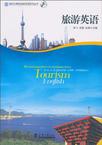旅游英语
出版时间:1970-1 出版社:李飞、袁露、 阮蓓 天津大学出版社 (2010-09出版) 作者:李飞,袁露,阮蓓 编 页数:249
前言
进入21世纪,中国的旅游业异军突起,蓬勃发展,越来越多的国外游客涌入中国,渴望了解古老的中华文明,富裕起来的中国人也热切地希望走出去,了解世界。然而,我国高素质的旅游从业人员数量有限,在一定程度上阻碍了我国旅游业的发展。因此,需要培养高素质的旅游专业人才,有效地与国际接轨,而这又要求必须重视并提升旅游专业外语教育水平。“当代大学生旅游英语系列丛书”在汲取了现有旅游英语教材精华的基础上,力图更为系统地对旅游业所涉及的内容以一个全新的视角编撰。本系列丛书包括《酒店英语》、《旅游英语》和《旅游客源国文化》三册,语言难度上由易到难,从初、中级阶段的《酒店英语》和《旅游英语》渐进到高级阶段的《旅游客源国文化》,教学内容丰富翔实,信息量大,具有强烈的时代感。“当代大学生旅游英语系列丛书”之《酒店英语》根据现代酒店的运营模式,以酒店的主营业务为主要线索,兼顾旅游者在旅行中对酒店业的认识,将内容分为5个部分,28个单元,7个模块。本书从认识酒店的概况入手,以对话、场景模拟练习为主,对酒店主要部门,比如前厅部、客房部、餐饮部等进行业务介绍,具有知识性、可读性和实用性。同时,加入知识链接部分,增加了趣味性。“当代大学生旅游英语系列丛书”之《旅游英语》精选了中国16个最具特色的旅游目的地的相关内容作为16个单元,每个单元分成4个模块:以“吃、住、行、游、购、娱”为特色的“听与说”模块;介绍代表性景点的“篇章阅读”模块;介绍相关人文历史风俗的“文化背景”模块;介绍旅游和常用应用文写作的“实用写作”模块。4个模块兼具知识性、可读性、趣味性和实用性,旨在提高旅游专业学生的专业英语实际运用能力,打好坚实的旅游会话基础,拓宽知识面,增强其成功就业的信心,提高其轻松从业的能力。
内容概要
《旅游英语》以中国主要旅游城市及景区的自然景观、人文景观、宾馆饭店、饮食文化、社会习俗、民族文化、公共节日、历史遗迹等方面为内容,旨在提高旅游专业学生的专业英语实际运用能力,帮助学生打好坚实的旅游会话基础,拓宽知识面,增强其成功就业的信心,提高其轻松从业的能力。 本教材精选了中国16个最具特色的旅游目的地为16个单元,每单元分为4个部分:第一部分“听与说”,融入了包含吃、住、行、游、购、娱为特色的对话内容,并列举出了常用表达范例,培养学生用英语进行口语交际的能力;第二部分“篇章阅读”,以介绍各地区具有代表性的自然或人文景点为主体,并配有专项练习,培养学生英语阅读和专业英语翻译能力;第三部分“文化背景”,针对每个单元所涉及的地区特点,精选了相关的人文历史、风土人情进行介绍,进一步扩大学生的信息资源,提升阅读能力;第四部分“实用写作”,以旅游和常用应用文写作为重心,培养学生参照范例用英语拟写各类函件、广告的能力。
书籍目录
Unit One Discover ChinaPart I . Listening and Practice / 1Part Ⅱ. Passage Reading / 4Part Ⅲ. Culture Background / 7Part Ⅳ. Practical Writing / 10Unit Two Beijing —— The City of RoyaltyPart I.Listening and Practice / 13Part Ⅱ. Passage Reading / 16Part Ⅲ. Culture Background / 21Part Ⅳ. Practical Writing / 24Unit Three Xi'an —— The Start Point of Silk RoadPart I. Listening and Practice / 27Part Ⅱ. Passage Reading / 30Part Ⅲ. Culture Background / 34Part Ⅳ. Practical Writing / 36Unit Four Dunhuang —— The Joint of the Four Oldest CivilizationsPart I. Listening and Practice / 41Part Ⅱ. Passage Reading / 44PartⅢ. Culture Background / 48Part Ⅳ. Practical Writing / 50Unit Five Xinjiang —— A CornucopiaPart Ⅰ. Listening and Practice / 52Part Ⅱ. Passage Reading / 55Part Ⅲ. Culture Background / 60Part Ⅳ. Practical Writing / 63Unit Six Tibet —— The Third Pole of the WorldPart Ⅰ Listening and Practice / 65Part Ⅱ. Passage Reading / 68Part Ⅲ. Culture Background / 73Part Ⅳ. Practical Writing / 75Unit Seven Yunnan —— A Colorful LandPart Ⅰ. Listening and Practice / 77Part Ⅱ. Passage Reading / 79Part Ⅲ. Culture Background / 84Part IV. Practical Writing / 87Unit Eight Sichuan —— The Land of AbundancePart Ⅰ. Listening and Practice / 89Part Ⅱ. Passage Reading / 92Part Ⅲ. Culture Background / 96Part IV. Practical Writing / 99Unit Nine Hubei —— The Thoroughfare Leading to Nine ProvincesPart I. Listening and Practice / 101Part Ⅱ. Passage Reading / 104Part Ⅲ. Cultural Background / 109Part Ⅳ. Practical Writing / 111Unit Ten Anhui —— The Land of JianghuaiPart I. Listening and Practice / 114Part Ⅱ. Passage Reading / 117Part Ⅲ. Culture Background / 121Part Ⅳ. Practical Writing / 125Unit Eleven Shandong —— Hometown of ConfucianPart Ⅰ .Listening and Practice / 128Part Ⅱ. Passage Reading / 130Part Ⅲ. Culture Background / 134Part Ⅳ. Practical Writing / 139Unit Twelve Guilin —— A Fairy Land under HeavenPart Ⅰ. Listening and Practice / 141Part Ⅱ. Passage Reading / 144Part Ⅲ. Culture Background / 148Part Ⅳ. Practical Writing / 150Unit Thirteen Shanghai —— Oriental PearlPart Ⅰ. Listening and Practice / 153Part Ⅱ. Passage Reading / 156Part Ⅲ. Culture Background / 160Part Ⅳ. Practical Writing / 163Unit Fourteen Suzhou and Hangzhou —— The Paradise on EarthPart Ⅰ. Listening and Practice / 166Part Ⅱ. Passage Reading / 169Part Ⅲ. Culture Background / 173Part Ⅳ. Practical Writing / 175Unit Fifteen Hong Kong —— An Invigorating MetropolisPart Ⅰ. Listening and Practice / 178Part Ⅱ. Passage Reading / 182Part Ⅲ. Culture Background / 186Part Ⅳ. Practical Writing / 189Unit Sixteen Taiwan —— The Treasured IslandPart Ⅰ. Listening and Practice / 191Part Ⅱ. Passage Reading / 194Part Ⅲ. Culture Background / 197Part Ⅳ. Practical Writing / 201Appendix / 2o3Reference / 249
章节摘录
插图:Sichuan cuisine is one of the most famous Chinese cuisines in the world.Characterized by its spicy and pungent flavor, Sichuan cuisine, prolific of tastes,emphasizes on the use of chili. Pepper also never fails to accompany, producingtypical exciting tastes. Besides, garlic, ginger and fermented soybean are alsoused in the cooking process. Wild vegetables and animals are usually chosen asingredients, while frying, frying without oil, pickling and braising are appliedas basic cooking techniques. It cannot be said that one who does not experienceSichuan food ever reaches China. Cantonese CuisineCantonese food originates from Guangdong, the southernmost province inChina. The majority of overseas Chinese people are from Gnangdong (Canton)so Cantonese is perhaps the most widely available Chinese regional cuisineoutside of China. Tasting clear, light, crisp and fresh, Cantonese cuisine,familiar to Westerners, usually chooses raptors and beasts to produce originativedishes. Its basic cooking techniques include roasting, stir-frying, sauteing, deep-frying, braising, stewing and steaming. Among them steaming and stir-fryingare more commonly applied to preserve the natural flavor. Gnangdong chefs alsopay much attention to the artistic presentation of dishes.
编辑推荐
《旅游英语》:当代大学生旅游英语系列丛书
图书封面
评论、评分、阅读与下载
用户评论 (总计0条)
相关图书
- (CD)HQ风华国韵:古琴.李祥庭 心
- (CD)HQ风华国韵:泛爱众 古筝.笛
- (CD)HQ风华国韵:箜篌 清明上河图
- 法语常见语法错误解析
- 1988:我想和这个世界谈谈
- 乡村旅游理论研究与案例实践
- 敦煌心灵之旅-快乐之门
- 微生物的故事
- 机械零件质量检测经验实例
- 怪物史瑞克3(DVD)
- 不整装不出门及其他50条荒谬的时尚法则
- 小学生读写有方双优训练二年级
- 小学生读写有方双优训练三年级
- 读写有方
- 税务会计实务
- 词话丛编 续编(全五册)
- 视觉天下
- I新课标高中地理必修1
- 白雪乌鸦
- 新日本语能力考试N4文字词汇强化训练
- 狼自北方来
- 好老师因材施教的12个方法
- 基本乐理与视唱练耳
- 新概念实用英语语法
- 心系人寰
